| |
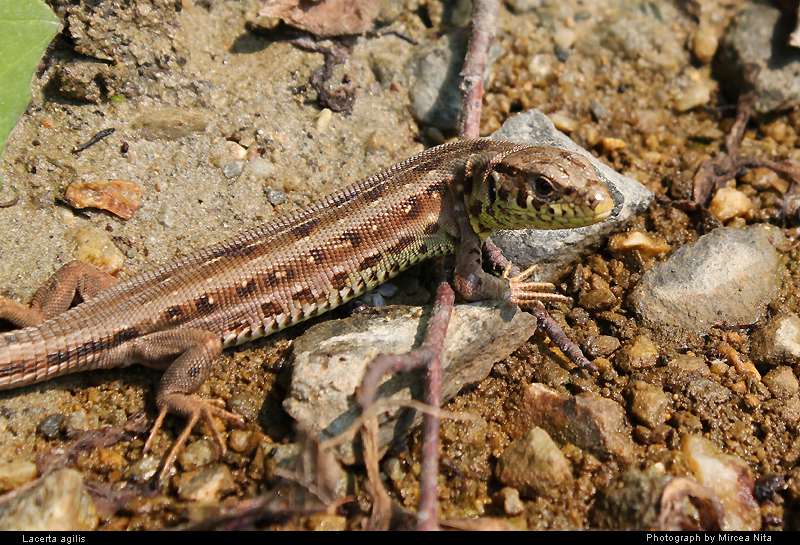
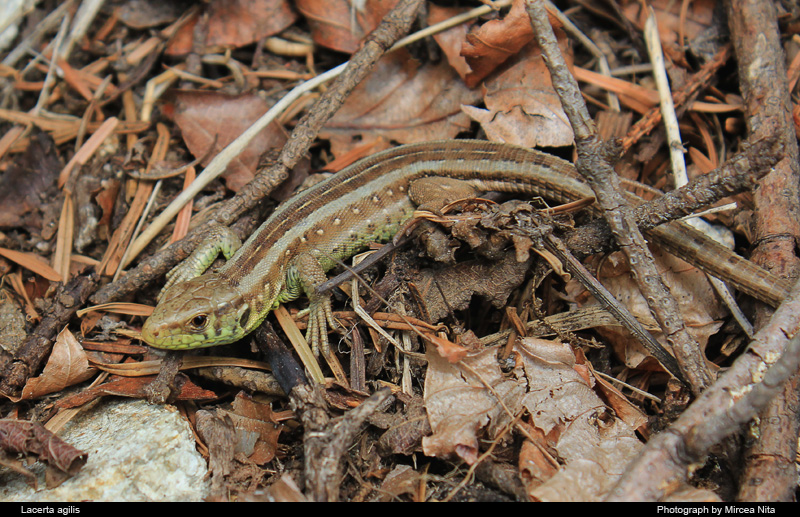
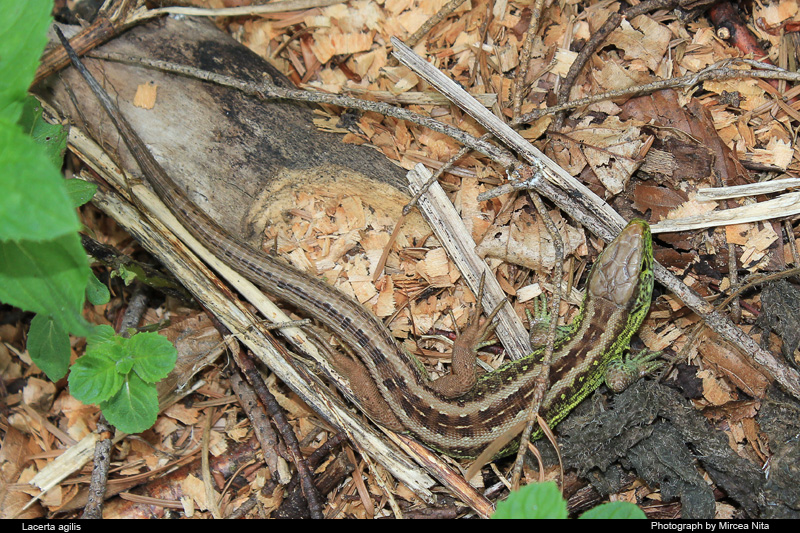
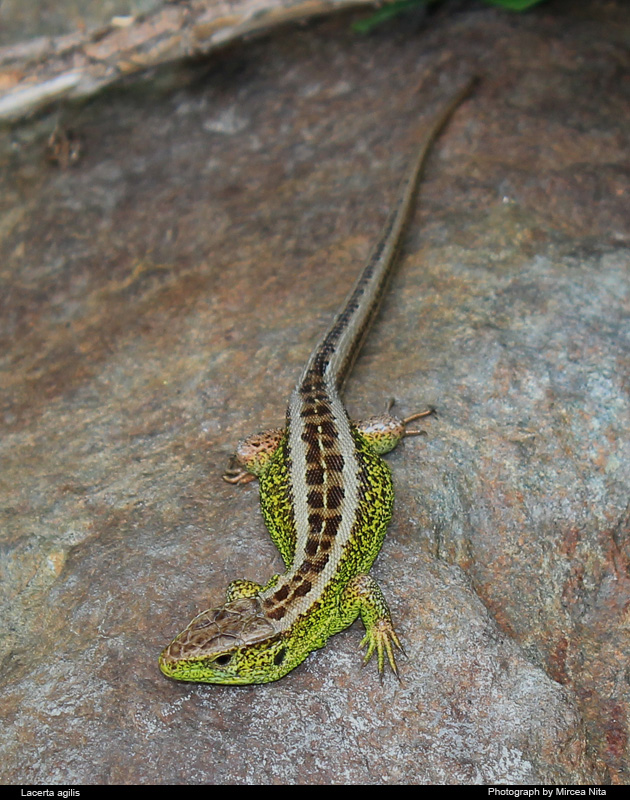

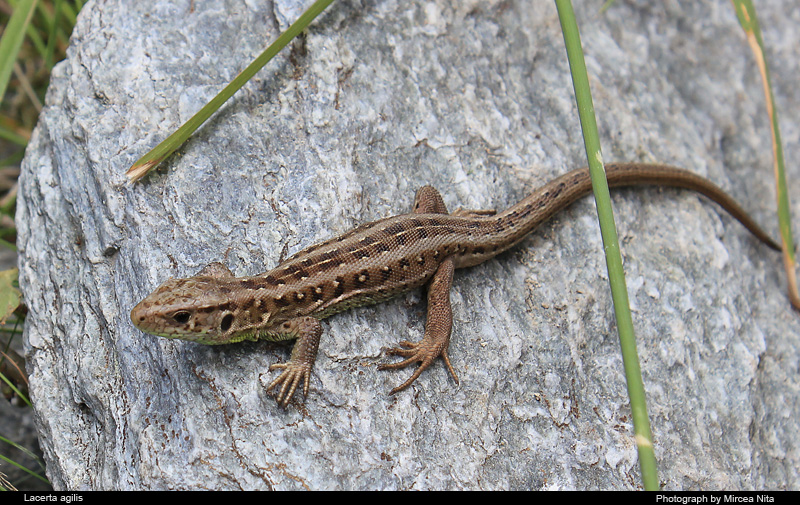
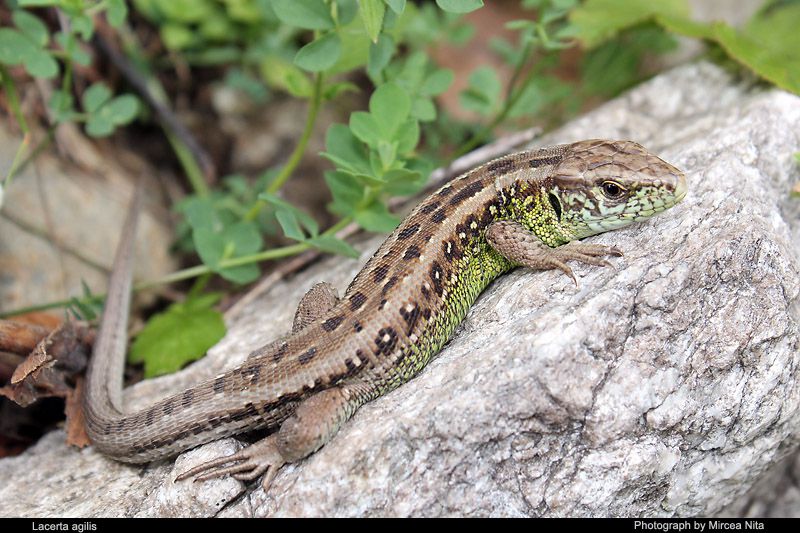
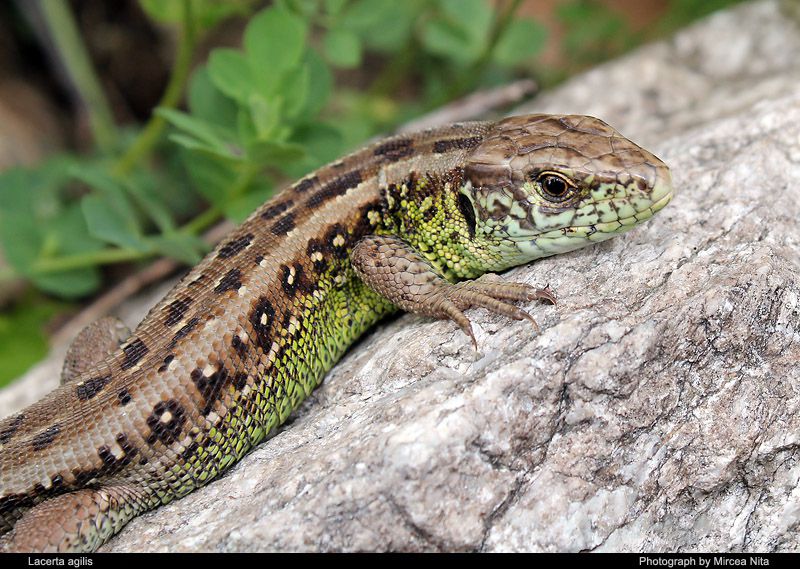
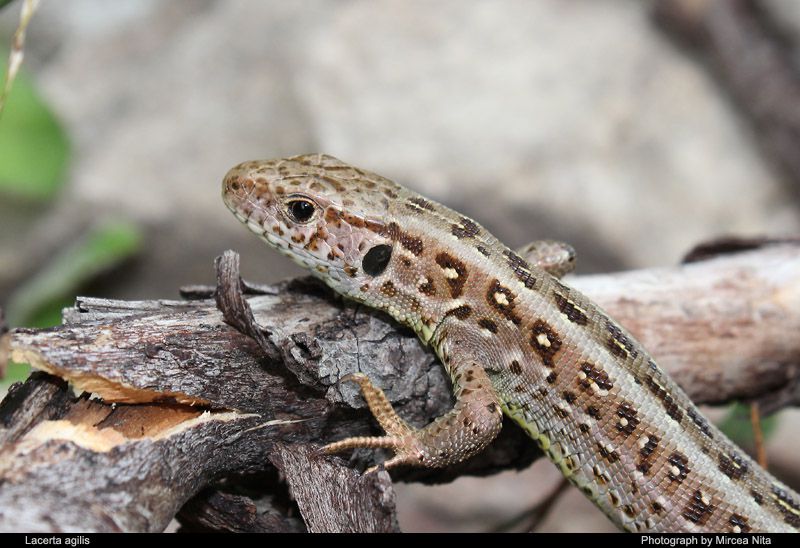
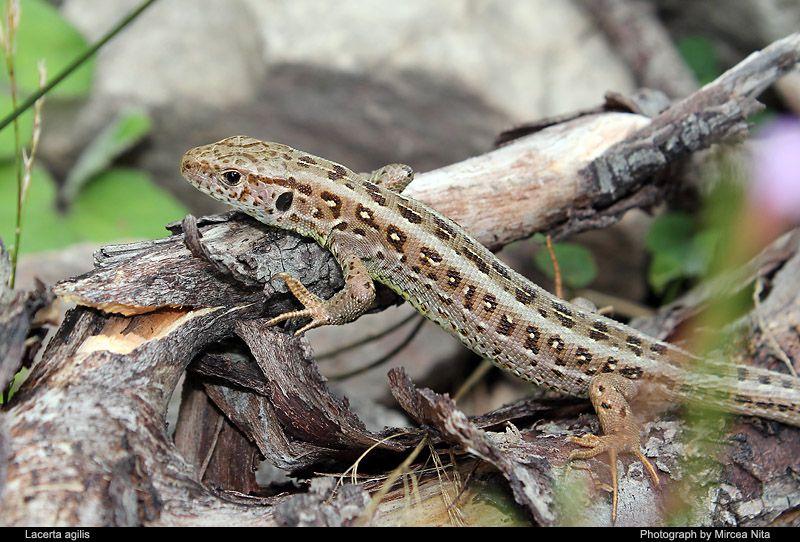
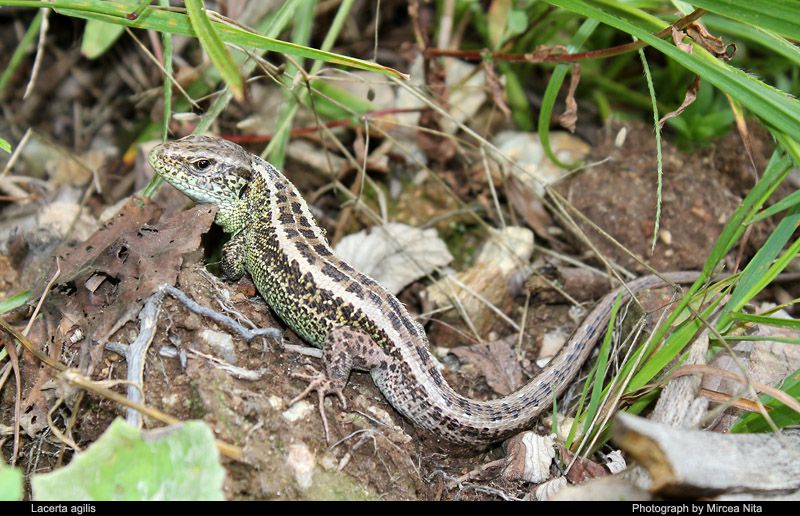
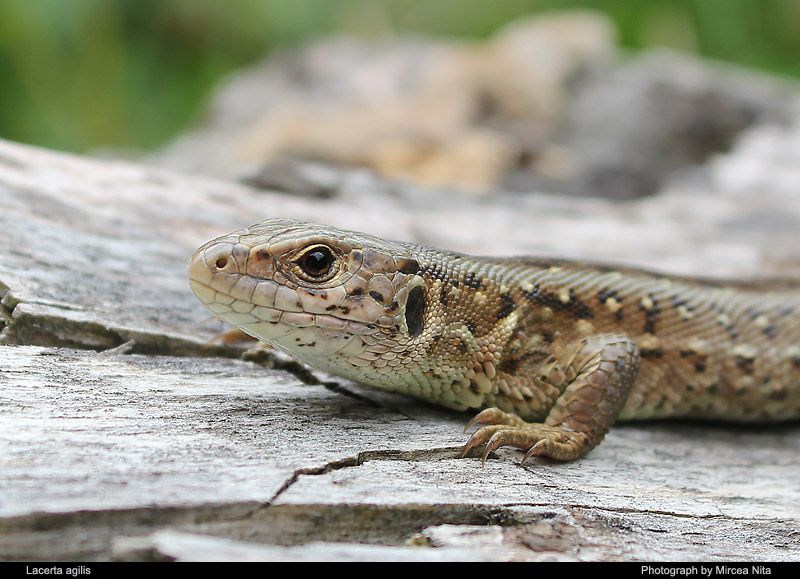
Lacerta agilis
Sand lizard - Lacerta agilis - Linnaeus, 1758
Description:
Lacerta agilis is a short-legged, rather robust lizard.
Total length is up to 25 cm; usually 20 - 23 cm (tail 13 - 15 cm) in males; in females 15 - 17 cm (tail 10 - 13 cm).
The head is short and convex with obtuse snout. Male sand lizards have noticeably larger heads than females. Neck is as broad as the head or broader, rarely a little constricted. The collar has serrated edge and is composed from 7 to 12 plates (usually 8 to 10). There are 8 to 12 rows of very narrow, strongly keeled scales on vertebral area, more or less sharply differentiated from the larger dorsolaterals which are much broader and also strongly keeled. Down on the sides the scales become smaller and then increase in size again. There are 33 to 47 scales (usually 36 to 40) across the middle of the body. Ventral plates are more or less distinct detached from each other in 6 or 8 longitudinal and 24 to 31 transverse series. The preanal plate is large, bordered by one, rarely by two semicircles of smaller plates.
The coloration and pattern of sand lizard varies with sub-species across their range (sometimes males have green flanks and uniform brown or orange back and females can be completely uniform brown-orange; for ssp. chersonensis the males can be completely green; for ssp. bosnica the males and females have a thin light line running down the middle of the back; for ssp. exigua they have 3 vivid lines on the top of the flanks and in the middle of the back.
Usually sand lizards have a pattern of dark spots with light centers over a background of brown or grey. Males are green on flanks - especially during mating season - fading in the late summer, females being more brownish. Sometimes their back is brick-red or tan, without markings or spots. Juveniles are usually uniform brown with two light brown lines on the top of the flanks; on the flanks they have light spots bordered by dark brown or black (ocelli). The top of the back has black markings with light spots inside the black marks. Adult females have better pronounced light stripes. Ventrally they are whitish grey with spots.
Anyway the taxonomy of Lacerta agillis needs further study.
Biology:
The sand lizards appear after hibernation in March - April (or even May - depending upon the weather conditions). After mating the eggs are laid in late May to June in burrows dug into the sand. The clutch numbers from 4 to 14 and the young hatch in July - August (incubation period lasts 50 - 55 days). In optimum conditions, the adults will mate again and produce a second clutch about 6 weeks after the first. During the winter months they hibernate in burrows.
The average life span for sand lizard is about 12 years, reaching their sexual maturity when they are two years old for males and three years for females.
Their diet consists mainly in invertebrates like insects and spiders. They have a lot of enemies like birds of prey, snakes, cats, etc.
A typical feature of lizards displayed by them is the dropping of the tail when captured in order to escape predators, the tail growing up again.
When escaping predators it moves very fast, taking refuge in holes in ground, under stones or bushy plants, at first sign of danger.
Habitat:
This species can be found in a wide range of habitats like subalpine and alpine meadows, coastal dunes, grassland, steppe, hedgerows, open woodland.
It is mainly a lowland species found from sea level up to 2350 m in southern Greece.
Distribution:
Range (on countries): Austria, Switzerland, Germany, France, Denmark, Sweden, SE Norway,
Czech Republic, Slovakia, Hungary, Bulgaria, Greece, Albania, N Balkan, Netherlands, Belgium, Luxemburg, S England, NE Italy, Croatia, Bosnia-Hertzegovina, Serbia, Macedonia, Montenegro, Romania, E Poland, Belorussia, Belarus, W Russia (in the north up to S Karelia and SE Finland, NE Caucasus), Russia (north of the Caucasus Mts., east up to Lake Baikal), Ukraina (east of the Dnjepr River and W Ukraina), Armenia, NE Turkey, Kazakhstan, Kirgistan (south up to Issyk Kul), NW China (W Xinjiang), Caucasian coast of the Black Sea in Russia near Sochi, Georgia (coastal region and upper Iori River in the Caucasus Mts.), Moldova, Latvia, Estonia, Lithuania, Azerbaijan, NW Mongolia;
agilis: Western Europe and western Central Europe;
boemica: S Russia (Dagestan), NE Caucasus
bosnica: Bulgaria, Greece, Croatia, Bosnia-Hertzegovina
brevicaudata: in northern and western Armenia, southern Georgia and on the southern slopes of the Great Caucasus range within the North Ossetia
chersonensis: Carpathian Mountains eastward, Romania.
exigua: the whole eastern part of the distribution range up to the Crimean Peninsula and Ciscaucasia in the south;
argus: Central Europe, east to the Carpathian Mountains and to eastern Poland;
garzoni: Spain (Gerona); type locality: "Falda oeste del Puig de Basa, Tossas, Pirineos, provincia de Gerona, Espan?a. 1850 msnm"; Holotype: MNCN 44271, female.
grusinica: Georgia, NE Turkey, Caucasus
ioriensis: Georgia; type locality: near Tianeti by the Iori river in E Georgia.
mzymtensis: Russia (Western Caucasus, high-mountains of the upper basing of Mzymta River; vicinity of Sochi).
Scientific name: Lacerta agilis
Common name: Sand lizard
Taxonomy:
Species: Lacerta agilis
Subspecies: Lacerta agilis agilis LINNAEUS, 1758
Lacerta agilis argus LAURENTI, 1768
Lacerta agilis boemica SUCHOW, 1929
Lacerta agilis bosnica SCHREIBER, 1912
Lacerta agilis chersonensis ANDRZEJOWSKI, 1832
Lacerta agilis exigua EICHWALD, 1831
Lacerta agilis garzoni Arribas, 1995 (eastern Pyrenees)
Lacerta agilis grusinica PETERS 1960
Lacerta agilis ioriensis PETERS & MUSKHELISCHWILI, 1968
Lacerta agilis brevicaudata PETERS, 1958
Lacerta agilis mzymtensis TUNIYEV & TUNIYEV 2008
IUCN status: LC (Least Concern)
Lacerta agilis is listed as Least Concern in view of its wide distribution, tolerance of a broad range of habitats, presumed large population, and because it is unlikely to be declining fast enough to qualify for listing in a more threatened category.
This species is listed on Appendix II of the Bern Convention, and on Annex IV of the European Union Habitats Directive, and is protected by national legislation in parts of its range. It occurs in a number of protected areas.
This species is threatened by habitat loss through agricultural intensification and pollution (largely from the use of agrochemicals). It is a threatened species in much of the northwest of its range, including the United Kingdom, Scandinavia and northern Germany, more research on its biology and threats and monitoring being needed.*
References:
Arnold, E.N. 2003. Reptiles and amphibians of Europe. Princeton University Press., Princeton and Oxford;
Arnold, E. N., Arribas, O. and Carranza, S. 2007. Systematics of the Palaearctic and Oriental lizard tribe Lacertini (Squamata: Lacertidae: Lacertinae), with descriptions of eight new genera. Zootaxa 1430: 1-86.
Boulenger, G.A. 1917. Descriptions of new lizards of the family Lacertidae. Ann. Mag. nat. Hist. (8) 19: 277-279;
Clark, R. (1999) - herpetofauna of Thassos, North Aegean Sea, Greece. - British Herpetological Society Bulletin, 66: 14-18;
Covaciu-Marcov, S.D., Cicort-Lucaciu, A.S., Dobre, F., Feren?i, S., Birceanu, M., Mihu?, R. & Str 2009. The herpetofauna of the Jiului Gorge National Park, Romania. North-Western Journal of Zoology 5 (Suppl. 1): 1-78;
Council of Europe. 2003. Convention on the Conservation of European Wildlife and Natural Habitats. Group of experts on the conservation of Amphibians and Reptiles. Mälmo (Sweden), 26-27 September 2003. Report T-PVS (2003) 18;
Fuhn, I. & S. Vancea, 1961: Fauna Republicii Romāne, 14. Reptilia (Testoase, Sopārle, Serpi). Bucuresti;
Gasc, J.-P., A. Cabela, J. Crnobrnja-Isailovic, D. Dolmen, K. Grossenbacher, P. Haffner, J. Lescure, H. Martens, J.P. Martinez-Rica, H. Maurin, M.E. Oliveira, T.S. Sofianidou, M. Veith & A. Zuiderwijk, 1997: Atlas of Amphibians and Reptiles in Europe. - Societas Europaea Herpetologica und Muséum National d'Historie Naturelle (IEGB/SPN), Paris;
Joger, U.; Fritz, U.; Guicking, D.; Kalyabina-Hauf, S.; Nagy, Z.T. & Wink, M. 2007. Phylogeography of western Palaearctic reptiles - Spatial and temporal speciation patterns. Zoologischer Anzeiger 246: 293-313;
*IUCN 2011. IUCN Red List of Threatened Species. Version 2011.2. ;
Szczerbak, N.N. 2003. Guide to the Reptiles of the Eastern Palearctic. Krieger, Malabar, FL, 260 pp;
Sos, T. 2008. Review of recent taxonomic and nomenclatural changes in European Amphibia and Reptilia related to Romanian herpetofauna. Herpetologica Romanica 2: 61-91.
Tuniyev Sako B. and Tuniyev Boris S. - INTRASPECIFIC VARIATION OF THE SAND LIZARD (Lacerta agilis) FROM THE WESTERN CAUCASUS AND DESCRIPTION OF A NEW SUBSPECIES Lacerta agilis mzymtensis ssp. nov. (REPTILIA: SAURIA) - April 12, 2007.
|
|

